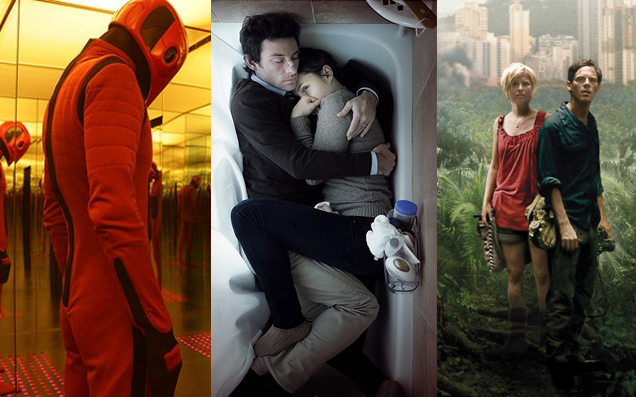
Alex Garland‘s Annihilation is solely on the small screen in Australia because both Garland and producer Scott Rudin pushed back at Paramount‘s insistence that the film needed to be edited so that it wasn’t “too intellectual” and “too complicated“ for cinema release, and thank fuck. What we ended up getting was a dreamlike, elusive, and beautiful take on loss, change, and the cyclic nature of life shown through the lens of some messed up science fiction terror.
Annihilation comfortably straddled the line between arthouse and science fiction, presenting a narrative that (for the most part) defies logical analysis – yes, there are things in there to be figured out, but the movie as a whole isn’t a puzzle to be solved; the mysteries of the movie are an artistic device, not a Rubik’s Cube to be completed.
If you’re in the mood for a hit of some more pensive, surreal, abstract science fiction (and you’ve already given Annihilation another watch or two), we’ve got you covered.
Monsters (2010)
The directorial debut of Gareth Edwards (you might know him from a little film called Rogue One), Monsters was a labour of love, with Edwards writing it, directing it, shooting it, and doing all the visual effects for it alone in his bedroom. The film is essentially a road movie, showing two characters who are reluctantly forced together as they cross through the ‘infected zone’, a walled-off section of Mexico which has been overrun with immense, tentacular alien creatures.
It was bafflingly marketed as an action movie on release, but in reality, it is a quiet, meditative journey through an alien (lol) landscape that reflects on beauty and violence and relationships. Scored by the British electronic artist Jon Hopkins, who rules, it’s gorgeous to look at, gorgeous to listen to, and very engaging. Give it a bash.
Upstream Color (2013)
Speaking of movies that can’t be solved like a Rubik’s Cube, Upstream Color director Shane Carruth‘s first film Primer was exactly the opposite of that. Behind the very sparse dialogue and plot in Primer is a fully-formed puzzle that can be completely solved based entirely on what’s shown in the film – it’s just almost impossible to do if you are a regular person. His follow-up, Upstream Color, went in a completely different direction, acting as more of a visual poem, in stark contrast to how Primer came across as a visual engineering textbook.
Upstream Color is ostensibly about the science fiction-y lifecycle of a fictional parasitic organism but more crucially about the relationship between two characters who find themselves completely lost, unable to communicate properly, but also experiencing a deep connection. Carruth did pretty much every conceivable job on this movie, from writing to directing to editing to scoring to designing to starring in it, and he did every single of those things perfectly.
The movie is visually stunning and a far better experience if you just sort of let it wash over you instead of trying to figure out what the fuck is going on.
Beyond the Black Rainbow (2010)
Sometimes in life you come across a piece of art which, despite never having consciously known it or been able to articulate it, you had always wanted to see. For me, this was Beyond the Black Rainbow. Created by director Panos Cosmatos (son of George P Cosmatos, who directed the amazing Stallone vehicle Cobra) as a ‘lost’ late-1970s sci-fi flick, the idea of the movie is loosely based on what he had assumed that era’s science fiction movies were about when he used to see the covers of their tapes at video stores as a kid.
The droning synth score by Jeremy Schmidt (the keyboard player from Canadian psych-rock band Black Mountain) is perfectly suited to the film’s slow-burn approach to narrative, which puts visuals and atmosphere way ahead of anything else. At times alienating but always gorgeous, this might leave you scratching your head a bit but you will be extremely happy that you watched it.
2001: A Space Odyssey (1968)
You have almost definitely already heard of 2001, but you’re doing yourself a huge disservice if you haven’t seen it yet. Meticulously designed by Kubrick at the height of his powers, 2001 is in no hurry to go anywhere but builds an incredible momentum towards a fever pitch of abstract imagery that the film (rightfully) refuses to explain in any way.
Weighing in at an impressive 161 minutes, every second of the movie is used perfectly to either further the narrative, world build, or show you some insanely cool shit.
Stalker (1979)
Loosely adapted from novel Roadside Picnic and, in turn, loosely adapted as the video game STALKER: Shadow of Chernobyl, Andrei Tarkovsky‘s Stalker probably has the most in common with Annihilation in terms of plot. The film follows a writer, a scientist, and their guide as they enter the mysterious ‘Zone‘, an area roped-off by the government in which the laws of reality just sort of stop applying and shit has a tendency to get real weird.
The action in Stalker is few and far between and focuses largely on the relationship between these three men and their varying levels of scepticism about the supernatural qualities of the Zone and the rumours that those who make it to the centre of the Zone will have their deepest wish come true. It’s beautifully shot and guaranteed to make you feel deeply uncomfortable for nearly the entire movie – but, like, in a good way.
Under the Skin (2013)
‘Scarlett Johansson is a murderous alien who drives around Scotland in an industrial van consuming horny men’ is a weird pitch but it sure makes for an excellent film. With lush, abstract visuals, a haunting score from experimental composer Mica Levi, and some amazing performances from some dudes who had literally never acted before in their lives and, at times, weren’t even aware they were being filmed, the movie tells its story entirely through character in a way that will keep you ruminating over it days later.
The film’s psychedelic style alone is enough to make it engaging but it’s also just weirdly otherworldly to see the male gaze inverted on itself and to see heterosexual male sexuality (usually shown as aggressive and forceful) as somewhat vulnerable. Also, there’s a bunch of dicks in it.
Bokeh (2017)
Definitely not the first movie to ask ‘What if all the people were gone?’ but maybe the most recent. Bokeh stars Matt O’Leary and Maika Monroe (who crushed it in It Follows) as a couple who wake up on holiday in Iceland to find that everyone else has disappeared, following them as they go through varying levels of acceptance of their completely unexplainable predicament.
Bokeh focuses less on the ‘going absolutely batshit insane’ aspect explored by others in the genre like The Quiet Earth, but is instead driven by each character’s different reaction to the prospect of being completely alone and how that subsequently affects their relationship. It’s thoughtful, gorgeously shot, and Maika Monroe is wonderful.
Ex Machina (2015)
This has largely worked its way into the list by virtue of sharing a director with Annihilation and also because it is the hottest Oscar Isaac has ever been, looking like something of a mix between Kool AD and an MMA fighter. Ex Machina is slick, sexy, and incredibly tense, a far less contemplative experience than the others in this list but still takes a lot of time to revel in its gorgeous setting and really let the actors give it their all.
Blade Runner (1982)
If you haven’t seen Blade Runner already, fuck you.







